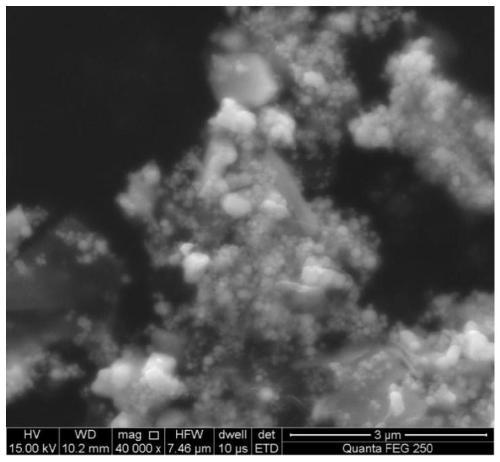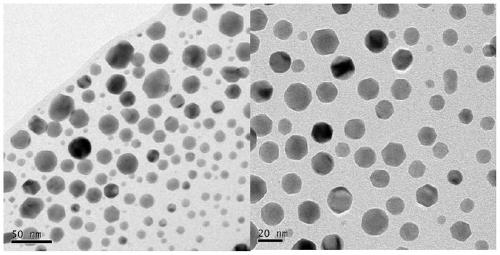C@Bi/rGO electro-adsorption composite active material, preparation and applications thereof
An active material and electro-adsorption technology, applied in water/sewage treatment equipment, water/sewage treatment, chemical instruments and methods, etc., can solve problems such as limiting the industrial application of CDI dechlorination technology, poor selectivity, and difficulty in adapting to treatment requirements , to achieve the effect of improving cycle stability, wide range of conditions, and good cycle reversibility
- Summary
- Abstract
- Description
- Claims
- Application Information
AI Technical Summary
Problems solved by technology
Method used
Image
Examples
Embodiment 1
[0092] Step 1: Active material preparation:
[0093] (1) Put 40mg of graphite oxide powder into 50ml of ethylene glycol at 15°C for 1h30min to obtain solution 1;
[0094] ⑵The 1gBi(NO 3 ) 3 ·5H 2 O, 1gNaOH, 500mg polyvinylpyrrolidone were put into 50ml ethylene glycol and stirred at 25°C to obtain solution 2;
[0095](3) Mix solution 1 and solution 2, stir at 25°C for 30 minutes, and 2 Under the atmosphere, heat the mixed solution with an oil bath at 110°C for 1 hour, and quickly add 10 g of ascorbic acid 5 minutes after the start of the reaction;
[0096] (4) The precipitate was obtained by centrifugation, washed three times with distilled water and alcohol, dried in a constant temperature drying oven at 60°C for 12 hours, and the product was ground to obtain the C@Bi / rGO composite material, in which bismuth accounted for 83.5%. See XRD diagram figure 1 , SEM image see figure 2 , TEM image see image 3 , see Ramantu Figure 4 , XPS figure see Figure 5 , thermogra...
Embodiment 2
[0105] Sodium chloride solution adsorption data:
[0106] The electrode prepared in Step 2 of Example 1 was used as the anode, and the activated carbon material was used as the cathode to form an asymmetric desalination system, using 3mM, 7mM, and 10mM sodium chloride solutions as electrolytes. The voltage during the cycle was 1.2V, and the adsorption rates after 10 cycles were 17.88mg / g, 33.39mg / g, and 51.78mg / g, respectively. Adsorption diagram see Figure 11 . The conductivity change curve in 3mM sodium chloride solution is shown in Figure 12 ;from Figure 11 , Figure 12 It can be seen that with the increase of the initial solution concentration, the adsorption capacity increases significantly, and the conductivity curve shows a periodic change, which reflects that the system has good cycle reversibility for sodium chloride solution.
Embodiment 3
[0108] Sodium fluoride solution adsorption data:
[0109] The electrode prepared in Step 2 of Example 1 was used as the anode, and the activated carbon material was used as the cathode to form an asymmetric desalination system, using 3mM, 7mM, and 10mM sodium fluoride solutions as electrolytes. The voltage in the cycling process was 1.2V, and the adsorption capacities after 10 cycles were 20.52mg / g, 36.33mg / g, and 118.78mg / g, respectively. Adsorption diagram see Figure 13 . The conductivity change curve in 3mM sodium fluoride solution is shown in Figure 14 ;from Figure 13 , Figure 14 It can be seen that with the increase of the initial solution concentration, the adsorption capacity increases significantly, and the conductivity curve shows a periodic change, which reflects that the system has good cycle reversibility for sodium chloride solution.
[0110] It can be seen from the above test data that the composite material and the bismuth anode material prepared by the...
PUM
| Property | Measurement | Unit |
|---|---|---|
| particle diameter | aaaaa | aaaaa |
| adsorption capacity | aaaaa | aaaaa |
Abstract
Description
Claims
Application Information
 Login to View More
Login to View More - R&D
- Intellectual Property
- Life Sciences
- Materials
- Tech Scout
- Unparalleled Data Quality
- Higher Quality Content
- 60% Fewer Hallucinations
Browse by: Latest US Patents, China's latest patents, Technical Efficacy Thesaurus, Application Domain, Technology Topic, Popular Technical Reports.
© 2025 PatSnap. All rights reserved.Legal|Privacy policy|Modern Slavery Act Transparency Statement|Sitemap|About US| Contact US: help@patsnap.com



